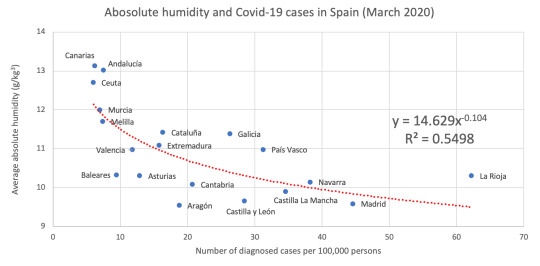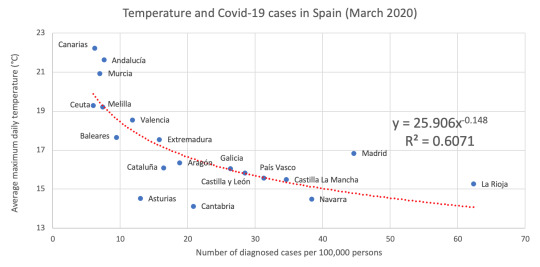Don't wanna be here? Send us removal request.
Text
Climate Matters: Atmospheric conditions and the spread of Covid-19 infection in Spain

The Iberian laboratory
Spain is one of the most climatically diverse countries in Western Europe, with a rapid transition from Atlantic maritime conditions on its northern coast to continental on the Meseta Central and a Mediterranean climate on its eastern and southern coasts, in addition to the desert climate of the Canary Islands. As such, it is an ideal environment for testing the hypothesis that Covid-19 infections spread more readily in cooler, dryer air than warmer, most moist conditions.
Why are viral infections seasonal?
The seasonality of flu infections has long been observed, and while various causes have been postulated for this (that the virus does not spread as easily in warmer, more humid air; that warmer weather boots the human immune system; that people are generally in closer proximity to each other during the winter months etc.), the question remains an open one.
Prior studies point to a role for climate
However, a study published in 2012 that was based on almost 30 years of county-level US data found that “approximately half of the average seasonal differences in US influenza mortality can be explained by seasonal differences in absolute humidity (AH) alone,” adding that “Temperature modestly influenced influenza mortality as well, although results were less robust.”
Most recently, a paper published in March 2020 found that “several countries between 30 degrees north and 30 degrees south, such as Australia, UAE, Qatar, Singapore, Bahrain, Qatar and Taiwan, have performed extensive testing per capita and the number of positive 2019-nCoV cases per capita are lower in these countries compared to several European countries and the US.” It concluded that “Even though currently available data is skewed by minimal testing per capita in many tropical countries, it is possible that weather plays a role in the spread of 2019-nCoV.”
Valencia dodges a bullet
Even a casual glance at data relating to Covid-19 cases in Spain reinforces this assertion. The case of Valencia is particularly striking: The first region of peninsular Spain to record a case of Covid-19 after thousands of Valencia fans travelled to Bergamo in Lombardy for a Champions League football match in mid-February, if might have been expected to be among the worst hit regions of the country.
However, with just 11.8 cases per 100,000 persons at the end of March (not much more than half of the regional average of 21.4), this has not been the case. Moreover, the southern regions of Andalucia and Murcia have the lowest rates of infection in mainland Spain, with the Canary Islands lower still (in spite of having the earliest diagnosed case in the whole country). All of these regions have relatively mild and humid winters compared to the Spanish average.

Source: https://www.mscbs.gob.es/profesionales/saludPublica/ccayes/alertasActual/nCov-China/documentos/Actualizacion_62_COVID-19.pdf
With this in mind, I decided to while away some of the long hours under house arrest lockdown here in Cataluña by examining the relationship between climate and Covid-19 infections in Spain in a more systematic manner.
Not everything is relative
Using daily readings on maximum temperature, air pressure, and relative humidity (RH) from all 19 Spanish regions (including the Balearic and Canary Islands, as well as the North African enclaves of Ceuta and Melilla) during the month of March to calculate levels of AH, I plotted both this and maximum temperatures by region against the number of Covid-19 cases per 100,000 of population at the end of March.
AH is the somewhat more obscure cousin of relative humidity (RH). While RH measures how much water is in the air compared to how much there could be, at a given temperature, as a percentage, AH expresses how much water is in the air, regardless of temperature, and is measured in g/m3. The ability of the air to hold water vapour is heavily dependent on temperature: At 30 degrees Celsius, the maximum AH is 30g/m3, while at 0 degrees, it is a mere 5g/m3.
Getting curvey
The results show a strong, non-linear association between both AH and temperature on the one hand and the prevalence of diagnosed cases of Covid-19 on the other (R2 values of 0.55 and 0.61, respectively).
Plotting infection rates against AH, a best-fit curve suggests that a significant negative relationship exists between the two variables but that it becomes much weaker once AH rises above 12g/m3.
Thus, while there was a significant difference in the number of Covid-19 cases per 100,000 persons between Madrid and Navarra (average AH of around 10g/m3) on the one hand and Extremadura and Valencia (average AH of around 11g/m3) on the other, there is relatively little difference between Melilla and Murcia (average AH of around 12g/m3) and the Canary Islands and Andalucia (average AH of around 13g/m3).

Source:
https://www.mscbs.gob.es/profesionales/saludPublica/ccayes/alertasActual/nCov-China/documentos/Actualizacion_62_COVID-19.pdf
https://www.weatheronline.co.uk/
A similar pattern is evident for maximum temperature, with a significant negative association between it and Covid-19 infection rates that becomes notably weaker once the former rises above 19 degrees Celsius.

Source:
https://www.mscbs.gob.es/profesionales/saludPublica/ccayes/alertasActual/nCov-China/documentos/Actualizacion_62_COVID-19.pdf
https://www.weatheronline.co.uk/
The mechanism through which atmospheric conditions influence the spread of Covid-19 remains an open question, but it has been suggested that virus particles stay airborne for longer, and thus travel further, in colder, drier air.
The limitations of Covid-19 data
The number of detected cases of Covid-19 is far less than the number of actual cases, as increased antibody testing is beginning to show in many countries. However, as long as these “invisible” cases are not geographically biased, this does not undermine the robustness of these findings.
Meanwhile, significant time lags are at play: Covid-19 is thought to have an incubation period of between two and 14 days, so some of those who were infected in March did not begin to show symptoms (and test positive) until April, while some of those who tested in positive in March were infected during February, introducing additional noise into the dataset.
Are tropical and subtropical climates less hospitable?
Despite these caveats, these findings indicate that Covid-19 transmission rates may fall significantly during the summer months. Of course, the corollary of this is that they would rise again next winter, but at least this would buy governments time to better prepare both their societies and their health care systems.
They also suggest that, particularly in a country like Spain, the policy response to Covid-19 should be much more regionally focused than it currently is in order to take account of significant differences in transmission rates between regions (this is an argument for flexibility, rather than an endorsement of seperatist movements).
The case for African exceptionalism
Areas with tropical and subtropical climates may have significantly lower rates of Covid-19 transmission than areas with more temperate climates. This implies that lockdown measures may be unnecessary in these regions. There is some evidence to back up this assertion: Despite recording its first case of Covid-19 during late February, Nigeria (with a population approaching 200 million) currently has less than 550 diagnosed cases, for example.
While this partially reflects lower levels of testing, the low level of infection in many African countries is striking: Currently, there are less than 120 diagnosed cases in Angola, Zambia, and Mozambique combined, for example. Meanwhile, Egypt, one of the worst affected countries in Africa, currently has just over 3,000 diagnosed cases in a population of 98 million (compared with close to 200,000 cases in Spain, which has less than half of its population - 47 million). Nor is there yet any real anecdotal evidence of healthcare systems coming under significant stress in Africa.
On the other hand, these findings also suggest that areas of relatively temperate climate in the Southern Hemisphere, such as South Africa and Argentina, may bear the brunt of the pandemic as they enter the winter season this year.
The gift of time
Napoleon and Hitler were both defeated in Russia by Generals “Janvier et Février,” and while Generals “Juillet et Août” will not vanquish Covid-19, they may buy valuable time to accumulate materiel (ventilators, testing kits, protective gear etc.), develop more effective treatments, and prepare a more rational and coherent and policy response in anticipation of a likely second wave next winter.
1 note
·
View note